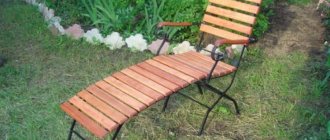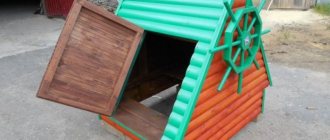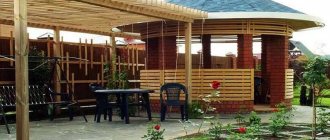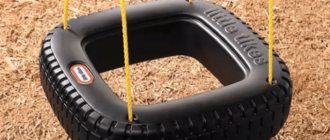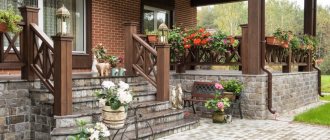The summer season is approaching and it's time to think about creating a chaise lounge with your own hands. It will allow you to enjoy your outdoor recreation to the fullest.
Chaise longue in French means long chair. This is a chair for relaxing. It can, at the owner’s request, change the position of the backrest.
DIY chaise longue
- 1 General recommendations
- 2 Monolithic chaise lounge made of wood
- 3 Assembling a chaise lounge on wheels
- 4 Simple lounger
- 5 Video of DIY garden lounger
- 6 Fabric chaise longue
- 7 DIY fabric chaise lounge. Model 2 7.1 Manufacturing process:
- 7.2 Model installation
- 9.1 Pay attention to another interesting chaise lounge model in the video.
- 10.1 Installation of the Kentucky chair
- 12.1 Unusual do-it-yourself deck chair
- 13.1 DIY pallet lounger video.
Sun loungers are widely used on beaches and by pools. On personal plots, dachas.
Sun loungers are made from various materials:
- wood;
- plastic;
- aluminum;
- rattan;
- PVC pipes;
- durable fabric.
Wooden sun loungers are the most popular and environmentally friendly. They come in a variety of shapes and designs. The disadvantage of monolithic wooden sun loungers is their weight. But this problem can be solved with the help of wheels.
Plastic sun loungers are characterized by easy mobility, ease of maintenance, and relatively low cost. Their minus is their fragility.
Fabric loungers are versatile and comfortable. Their frame is made of wood, metal or PVC pipes. They fold easily and do not take up much space.
Rattan sun loungers look great in the lap of nature. They are environmentally friendly. However, purchasing them is expensive. If you have sufficient skills, you can simply weave a rattan lounger yourself.
In this article we will tell you how to create wooden sun loungers with your own hands.
General recommendations
To ensure the longevity of the effort expended, the materials used must be processed.
Antiseptics and special impregnations will help protect wood from moisture, harmful insects, rot, and mold. It is better to carry out processing before assembling the structure.
After installing the sunbed, the wooden parts should be coated with primer, drying oil, varnish or paint. This will extend the life of your masterpiece.
Fabrics should also be protected from rain and sun. Water-repellent impregnations will help preserve their brightness and service. Their effect lasts 2-4 weeks.
And, of course, remember the famous Russian proverb when working. Measure seven times, cut once.
Requirements for homemade furniture
Any furniture intended for outdoor use must meet a number of requirements:
- Sufficient size. When developing a drawing, it is imperative to take into account the anatomical features of the future user. To calculate the angle of the backrest, it is better to use furniture construction standards. Correctly selected parameters will allow you to avoid pain in the back and neck, while ensuring normal blood circulation and comfort during rest.
- The height of the sun lounger should be optimal, especially for young children.
- Almost all models of sun loungers have a rigid frame (most often made of wooden boards). However, you should take care in advance about sewing a soft mattress or pillows.
- The safety of homemade furniture is one of the most important requirements for a craftsman. During the final assembly of the structure, it is necessary to carefully inspect all parts for defects, chips, cracks, and signs of surface damage by pests. All existing irregularities should be removed by grinding the parts.
- Particular attention is paid to pre-impregnation of all wooden surfaces with an antiseptic, antipyrine and moisture-resistant composition. As the main impregnation, you can use a production solution or a mixture of drying oil, turpentine, and melted paraffin.
When assembling folding models, sufficient attention is paid to the condition of the rotary fittings (reliability of fastening, absence of manufacturing defects, possibility of subsequent replacement).
During operation, preventive inspections of fittings and fasteners should be carried out at regular intervals.
Monolithic chaise lounge made of wood
Solid models are heavy. Therefore, to make it easier to carry, wheels are added to the headboard. The following instructions will help you make a chaise lounge on wheels with your own hands.
You will need tools:
- electric jigsaw or hacksaw;
- drill;
- screwdriver;
- self-tapping screws;
- fine grain sandpaper;
- spirit level;
- roulette.
When choosing a tree, pay attention to coniferous species. They are sold at affordable prices and are characterized by increased water resistance. Materials needed for a sun lounger:
- glued slab made of wood, its thickness should be 2 cm or more; at least 2 cm thick.
- boards 0.25 cm thick.
- wooden beam with a square section of 50x50 mm;
- 4 wheels with a diameter of 10cm;
- corners for strengthening the bed;
- door hinges;
- varnish or paint.
We suggest you make a chaise lounge according to this pattern.
Legend:
- Front legs.
- Hind legs.
- Bearing longitudinal.
- Back support.
- Back support.
- Bearing transverse.
- Fixing bar.
- Backrest support.
- Wheels.
- End beam.
- Back slats.
- Seat slats.
- The support beam is transverse.
- Fixing bar.
You can independently determine the size of the desired sun lounger and make calculations. Or use the standard size 60x190 cm. It is the most optimal and ergonomic for the average adult.
Assembling a chaise lounge on wheels
We assemble the base frame from the bars. We secure the load-bearing parts with corners similar to those that secure the base of the bed.
We sheathe the resulting frame with pre-prepared and sanded boards.
We make blanks for the legs from timber. Their height usually ranges from 5-10 cm. Choose one that is comfortable for yourself and your household.
We drill holes with a drill, retreating 5-7 cm from the ends of the longitudinal sides. We secure the legs with long bolts. We control the horizontal side with a spirit level.
We screw the wheels to the center of the legs with bolts with a diameter of 30mm.
Let's start cutting the lattice elements. Use a hacksaw or jigsaw to cut 8x60cm boards.
Using self-tapping screws and a screwdriver, screw the slats to the chaise lounge frame. Since the boards are not screwed tightly, we use spacers to obtain even gaps.
We should have two parts. The smaller one is intended for the headboard. We connect both grilles with door hinges. We install a support bar under the opening part.
All that remains is to sand off the production flaws. Apply wood primer. Paint it in your favorite color and the chaise longue with your own hands is ready.
For a more comfortable stay, you can sew additional mattresses that fit the size of the bed.
What tools and materials will be needed
The most difficult task in making a sun lounger involves finding quality wood. You will need blanks in the form of timber measuring 60x30 mm or 60x20 mm. The material must be perfect, without knots or damaged fibers. The design of the folding chaise lounge is such that in the main vertical posts you will need to make at least two drilling points for holes for an M8x50 bolt.
This significantly weakens the frame of the chaise lounge; folding furniture should be made only from oak or walnut, or, in extreme cases, acacia or elm. No pine, poplar or any hardwood.
For a soft base, you can use a tarpaulin, but in this case it is better to make a cover from a higher quality fabric over the seat. Sitting on a canvas base is not as comfortable as it might seem at first glance.
The tools you need are a hand or electric saw, an electric sharpener with an emery wheel, and an electric drill with a set of drills.
Material calculation
A list of parts for making a folding chaise longue is given in the addition to the drawing.
The total consumption of materials is as follows:
- A block of oak wood 60x20 mm in the amount of 6.3 m;
- Pine block 20x40 mm - 2.2 m.
To assemble a folding chaise longue, you will need a pair of screw-nut M8x50 in the amount of 4 pcs. and wood screws, 45-60 mm long, at least 10 pcs. In addition, wooden blanks will need to be coated with high-quality acrylic or oil varnish.
Simple sun lounger
To create a wooden chaise lounge with your own hands, you need the following materials, as well as tools:
- tape measure and square;
- pencil;
- saw;
- electric drill;
- screwdriver or screwdriver;
- screws, self-tapping screws and studs for fixation;
- sandpaper or grinder;
- wood putty;
- dye.
Wooden beams used in the work:
- for the back of the chaise lounge, take boards 5×10 with a length of 88 cm - 2 pieces, 39 cm - 3 pieces, 60 cm - 1 piece;
- 2 longitudinal bars for a frame 215 cm long;
- 2 cross beams -50 cm;
- 6 legs -35 cm;
- 13 slats for a seat measuring 2.5 x 8 x 60 cm;
- 6 slats for the back - 2.5? 8? 88 cm.
The first priority is to create a very strong frame. We take two parts 215 cm long, connect them with screws to half-meter transverse parts.
Let's move on to sitting. Take all the 60 cm slats. Attach them to the frame with self-tapping screws, leaving small gaps. To ensure that the gaps are even and uniform, use spacers 1 cm thick.
We create the legs of the lounger. To give maximum stability to the chaise longue, two legs are nailed at once at the legs. One at a time at the head. The instructions indicate bars with a height of 35 cm. But you can choose a height that is comfortable for you
We make the back from 2 boards measuring 88 cm and 3 boards measuring 39 cm. The resulting frame should easily fit into the base, leaving a small gap between the structures.
We securely fasten the longitudinal strips. We round them for a more beautiful look.
Attach the backrest to the base of the lounger. To do this, you need to drill holes at a distance of 9cm from the edge of the seat. Secure with pins.
We make 2 grooves at the base of the sun lounger for the support bars. The first 5x10 cm notch should be approximately 9 cm from the stud. The second is 20cm from the first. But its depth will be only 5x5 cm.
A 60cm beam is inserted horizontally into the first recess. To change the position, the board is transferred vertically to the second recess.
Sand all rough edges and imperfections. Process it. Cover with paint or varnish. The chaise lounge is ready with your own hands.
Kinds
First, you should decide on the type of sun lounger. It can be made of wood, aluminum, plastic and synthetic fabrics. We will focus on a practical and easy-to-manufacture option - a wooden chaise lounge.
The wood for the product and its design is selected depending on:
- your preferences;
- availability of available materials;
- financial capabilities;
- style of your garden.
When choosing wood for a future sun lounger, you should take into account the physical and mechanical properties of certain types of wood. For example, beech, ash, larch or oak will last the longest. These are strong and durable materials, and they also have an aesthetic appearance. But this type of wood is quite expensive and weighs more than other types of wood, which makes the finished products more difficult to move.
A chaise lounge made with your own hands will not only save your money, but will also improve the garden and give it exclusivity. There is a varied variety of wooden chaise lounge designs.
Fabric chaise lounge
A chair with a frame complemented with fabric is one of the most comfortable, budget types of chaise lounges. It is convenient to fold and easy to carry. Can be stored flat. It takes up little space.
To create a sun lounger with your own hands you will need:
- bolts, nuts with a diameter of 8 cm;
- small nails with round heads;
- round sticks (1 piece -65cm, 2 pieces - 50cm, 2 pieces -60cm);
- rectangular bars 25x60cm thick (2 pieces 120cm, 100cm and 60cm long);
- needle file, fine-grain sandpaper;
- glue;
- durable material measuring 200 by 50 cm.
Choose materials carefully so that your work is not in vain. Hardwood blocks are perfect for a sun lounger. Choose:
- birch;
- oak;
- beech.
Choose fabrics with maximum strength. Great fit:
- teak for mattresses;
- tarpaulin;
- canvas;
- camouflage;
- denim
These materials have increased wear resistance and will last you a long time. Let's move on to creating a sun lounger with our own hands. The base consists of three frames:
- A.1200x600 mm.
- B.1100x550 mm.
- H.650x620 mm.
Cut the boards to the required length. We sand with sandpaper.
In the longitudinal bars we make indents of 70 and 40 cm, and drill holes with a diameter of 8 mm with a drill, just like the bolts. Sand with a round file.
We make cutouts in part B. They will allow you to change the position of the back later. To do this, retreat 7-10 centimeters. It is necessary to cut 3 or 4 recesses. We polish well.
According to the diagram, we drill holes in the bars to connect the parts.
Assembling the base of the lounger. We connect frames A and B using screws. Then we connect frames A and B. For greater reliability, we lubricate the ends of the round slats with PVA before assembly. The frame of the sun lounger is ready.
Now you need to sew the seat. Place the material on the bed in the folded position. The fabric should be slightly stretched. Measure the desired length. Hem the edges. This way you will increase the wear resistance of the material. The chair will look neater.
We attach the fabric base to the lounger. We wrap round slats on parts A and B. We nail them with small nails with round heads. The chair is ready.
ADVICE. The edges of the fabric base can be made in the form of loops. In this case, the seat is simply strung on slats.
Sewing a soft cover
Having a soft pillow or mattress on a wooden chaise lounge will be a definite advantage.
- For tailoring, you should choose textiles very carefully.
- For ease of subsequent care, it is better to sew two covers: an inner and an outer removable cover.
- When dirty or before the winter season, the outer part can be washed without damaging the filling.
- The size of the pillow or mattress can vary, but as a rule, it should completely cover the lower and upper bed.
DIY fabric chaise lounge. Model 2
For this chair you will need:
- wooden slats measuring 2x4 cm. Two slats each with a length of 122cm, 112cm, 38cm. One piece each 61 cm, 65 cm, 57 cm. And four slats 60cm long;
- slats measuring 2x6 cm. One each 61 and 57 cm;
- 65cm wooden rod with a diameter of 1.2cm;
- a piece of fabric 137 cm long and 116 cm wide;
- bolts, washers, nuts, screws;
- glue;
- round needle file, sandpaper or grinder;
- electric drill.
Manufacturing process:
Process all the details of the future chair in advance. Sand them using a machine or fine-grained sandpaper. Cover with special impregnations that protect the wood from corrosion. Appreciate your work.
Pay attention to the drawing. The crossbars at the bottom of the legs help fix the position of the backrest. Make them. Or cuts, retreating from the edge by approximately 20, 25, 30 and 35 cm.
Drill holes for the bolts in the back frame. To do this, measure 41cm on each side.
On the seat frame, step back 43cm from the top. Make holes.
On the piece supporting the back, drill holes in the center of the edges.
Process all holes with a round file.
Model installation
First assemble the back frame. A beam 61 cm long will carry a large body load. Secure it as securely as possible. Leave a small gap between the two slats. The tissue will be fixed through it.
Assemble the seat. Fold it with the back frame. Be sure to place a washer between them. Bolt the frames together.
ADVICE. To prevent the nuts from loosening quickly, tighten an additional lock nut on top. For greater reliability, attach the nuts to glue, varnish or paint. First tighten the nut. Then loosen it slightly so that the parts rotate freely.
Install the back support piece using washers and bolts.
Sand away all imperfections. If desired, varnish or paint.
Fold the fabric in half, sew, retreating 1.5 centimeters from the edge. Turn it inside out. Fold the edge of the material for the rods that secure the panel between the slats. Sew.
Now insert the material between the slats. Secure with a rod. This installation model allows you to remove the fabric for washing without much effort.
Chaise lounge made of polyvinyl chloride
Another example of a lounger with a fabric base. Only in this case, wooden slats are replaced with PVC pipes. Chair sizes may vary.
In this do-it-yourself chaise lounge model we used:
- 2-inch polyvinyl chloride pipes;
- L-shaped connectors – 8 pieces;
- T-shaped connectors – 6 pieces.
First, connect 30cm and 45cm long PVC pipes for the vertical strip using a T-connector. Place L-shaped connectors on the ends. Connect the second vertical in the same way.
Now you need to connect the two sides together. Please note that one horizontal crossbar is solid. Its length is 66cm. It is attached closer to the T-shaped connection, which in turn should be directed into the structure. The second side consists of two 30cm pipes, combined with a T-shaped adapter, turned at an angle of 45 degrees from the long side of the strip.
Do not hurry. Measure pipes accurately. As a result, you should end up with a rectangular structure.
Now is the time to make the connection on which the seat will rotate. To do this, insert a 5cm long pipe into the T-shaped connector and secure it with another T-shaped adapter. It will become the basis of the horizontal frame.
Make the long sides similar to the vertical section, using 30 and 45 cm pipes with an L-shaped connector. For crossbars, use a solid tube 30cm long. And also consisting of 2 x 20 cm with a T-shaped adapter.
You did everything right if you get a rectangle within a rectangle.
The seat is located between a long section of the vertical section and a short section of the horizontal section. Adjust the level of inclination that is comfortable for you. Measure the distance between the two free T-pieces. Cut the pipe to the required length. Insert the rear support.
Take measurements of the fabric consumption for your chair. Use thick fabric. For example, canvas, tarpaulin, jeans. Hem the edges and secure the fabric to the chaise lounge. Enjoy your holiday.
Let's move on to the anatomical
Making a hard anatomical chaise lounge is much more difficult than a soft one, and you cannot carry/carry it with you, but relaxing in it will be much more pleasant and fulfilling. First, let's determine the purpose of the product. For relaxation after hard work and/or elderly people, you need a chaise longue with a low back and a deep dip under the pelvic area, pos. And in Fig. For the beach and general relaxation, a chaise lounge with a raised back and a small smooth protrusion under the lower back is more suitable. In the first case, it is necessary to ensure the drainage of blood from loaded (possibly sick) legs; in the second - to prevent it from flowing to the legs. Of course, the best would be a transformable chaise longue, which allows you to implement one or another anatomical scheme.
Anatomical types of hard sun loungers
Note: Americans of pre-liberal times lifted their feet on the table at every opportunity, and it was not their rudeness at all. At that time, only managers of at least middle management worked sitting in a chair, and the rest, like wolves, were fed by their feet.
Topchan
Let's start with something simple, without any physiological and anatomical subtleties. You can relax quite decently on an ordinary beach couch, but is it possible to somehow improve it without complicating it or making it more expensive?
Drawings of a simple beach lounge chair with an adjustable headboard are shown on the left in the figure, and on the right there - with the same improvement that makes the bed more ergonomic. Specifically, with slightly profiled sidewalls. In this case, it is better to use a regular construction board on the drawers, 2-3 times impregnated with eco-soil; flooring - from slats 30x30 or 40x40. This chaise lounge can either be painted or varnished with acrylic varnish for exterior use in 3-4 layers; in this case, the wood will not fade in 4-6 years.
Drawings of hard chaise lounges and trestle beds
Frame or beams?
Frame in Russian frame without any Hi-Tech. Frame structures are now commonly called structures with a supporting frame and non-functional cladding; again in Russian, frame.
Frame load-bearing circuits (see, for example, on the left in the figure) are widely used in the production of furniture, incl. anatomical sun loungers in the economy and mid-price segment, thanks to minimal material consumption; their labor intensity in automated production is also low. Flooring on a frame frame (claims regarding tautology - to the authors of the term) can be laid from longitudinal or transverse lamellas. But for an amateur working in a garage or on a balcony, the frame design is clearly a bit complicated.
Frame and beam structures of anatomical chaise lounge
If you look closely at the photos of expensive/elite anatomical sun loungers, it turns out that most of them are made according to a beam design with a working longitudinal covering of the flooring (on the right in the figure); The transverse beams are laid on the frames without insertion and are attached to them with self-tapping screws. The point here is not only and not so much in the “coolness of the money” - relaxing on a sun lounger with a longitudinal flooring is much more complete, because The ribs of the lamellas are not felt by the body even through a single-layer terry blanket. In addition, the lamellas can be made of one layer of 6 mm plywood and are mounted plastically immediately after impregnation without plaza directly in place, see above. But the flooring of the bed of a beamed sun lounger can only be longitudinal, because its casing is working.
Note: in fact, the only case when the bed of an anatomical chaise longue is possible only from transverse slats is a quick-assembled/dismountable chaise lounge like the one in Fig. on the right or shown in the video below:
Video: anatomical chaise lounge chair
Portable lounge chair
The durable, lightweight chair is quickly assembled and disassembled. It is convenient to take it with you outdoors. The model is so easy to make that it is suitable even for novice craftsmen.
The collapsible chair consists of 2 parts:
- backrest covered with dense, wear-resistant fabric;
- wooden seat.
To create a chair, it is recommended to take cherry boards for the upper crosspieces and seat, as well as maple for the legs and supporting parts. You can also use pine wood.
In addition to tools, the following materials are used:
- 2 legs for the backrest measuring 20x40x800mm;
- 2 legs for the seat - 20x40x560mm;
- 2 lower crossbars - 10x50x380mm;
- 1 top crossbar - 10x40x380mm;
- 1 seat crossbar - 20x40x300mm;
- 5 slats - 20x40x400mm;
- piece of material - 600x500mm.
The procedure for assembling a portable sun lounger is shown in the diagram.
First, the parts are connected using self-tapping screws and a screwdriver.
The workpiece is processed and varnished.
While the frame dries, the fabric is folded and stitched. Then it is nailed using staples and a construction stapler to a wooden piece.
We connect the back and seat of the chaise lounge.
Enjoying your holiday in your new armchair.
Pay attention to another interesting chaise lounge model in the video.
Classification by type of construction
There are three main types of designs inherent in sun loungers:
- Monolithic structure: to create it, it is necessary to connect all the components so that it cannot be disassembled in the future. This chaise lounge is particularly durable, which is an undeniable advantage. Speaking of disadvantages, we can note the fact that you will not be able to adjust the position of the backrest, and if necessary, you will not be able to fold the chaise longue. It follows from this that it will be extremely inconvenient to transport it;
- Portable design: as the name suggests, its features allow further assembly and disassembly of furniture. This chaise lounge is equipped with a special mechanism thanks to which you can adjust the position of the backrest;
Soldered design with inserts: As a plus, it has a rather attractive appearance. The disadvantage of the design is that the presence of inserts made of other materials does not guarantee its strength and durability.
Kentucky chair
You can make the original look of a chaise lounge with your own hands. A sun lounger is assembled from bars. Convenient, easy to fold. Takes up minimal storage space.
For the chair you will need:
- 4mm galvanized wire;
- 16 staples;
- bars 30x55 mm.
Before starting assembly, it is recommended to treat the bars to protect them from ultraviolet rays and moisture. Choose an oil- and wax-based stain. Beitz is good. You can use parquet oil. Apply the product using a spray bottle or brush.
Kentucky chair installation
Drill the holes. Their diameter should be slightly wider than the thickness of the galvanized wire. Sand all rough spots and imperfections.
Fold the parts according to the photo and start stringing the boards onto the wire.
Secure it with brackets.
ADVICE. Instead of wire, use galvanized studs. They are secured with nuts and washers.
Raise the planks. The Kentucky chair is ready for use.
Original chaise lounge
Design Koalition has developed an unusual chaise lounge with a fabric canopy that will allow you to enjoy outdoor recreation even on a hot day, protecting you from the scorching sun. The cost of such a sun lounger is 5970 euros. We will tell you how to save money and make an original chaise lounge with your own hands.
To create a lounger you will need the following materials. And also tools:
- 2 sheets of plywood 2cm thick with a size of 160x180cm;
- 6 round strips with a diameter of 30mm and a length of 92cm;
- 12 planks made from leftover plywood measuring 94x10cm;
- dense fabric with a width of 92 cm;
- construction adhesive;
- screws;
- roulette;
- cardboard for layout;
- Circular Saw;
- electric drill.
Let's start creating a sun lounger.
Transfer the diagram onto cardboard or thick paper. To make the task easier, you can first draw it into squares of 10 by 10 cm. The template makes it easy to correct all the shortcomings on paper. Subsequently, you will only circle it 2 times. Or maybe you’ll get the hang of it and make a few chairs for relaxation.
We transfer the drawing onto sheets of plywood and cut out the side parts with a circular or band saw. At the junction with the round beam, we cut out recesses with a diameter of 30mm.
We sand all the unevenness and cutting defects.
We assemble a rigid structure. Lubricate the ends of the beam with wood glue or PVA. We insert the timber into the recesses and fasten it with screws. The joints can be additionally treated with glue for maximum reliability.
Now you need to put the structure on its side. Place weights on the gluing areas. And let the chaise longue dry completely.
We begin to screw the planks to the ribs of the structure. At the same time, we make a 10-12 cm long indentation between them. Tighten the screws deeper so that their heads do not cling to the fabric and tear it.
We sand the product again. Now we hide the assembly flaws.
Use wood putty to hide all the screw heads in the places where the fabric is tensioned. We paint the chaise lounge.
You probably noticed that the description only gives the approximate width of the awning. The fact is that you can decide to cover the chaise longue entirely with fabric, or just make a canopy. Decide for yourself. Measure the dimensions and sew the awning.
ADVICE. It is better to fasten the awning with ties or Velcro. This will allow you to remove the fabric at any time and wash it without problems.
Materials
For soft seats, dense, water-resistant fabric coated with polyurethane is suitable. Tarpaulin is also suitable, as is any thick fabric. The rigid structure is made from natural materials (wood, wicker) or plastic.
Array
There are tree species, the solids of which look noble and have good mechanical properties. These are larch, ash, beech, oak. It is from them that durable garden furniture is made. A folding or monolithic chair made of valuable wood will decorate the garden.
Hevea
Garden furniture made from Hevea is resistant to moisture and is not afraid of wood-boring beetles. In terms of its properties, this wood is not inferior to oak. It is classified as a hard variety. The material contains rubber, so a chaise longue made from hevea does not dry out.
Plywood
It is made from wood veneer. Its layers are glued together with special glue. Durable fabrics of different thicknesses are obtained. Plywood is suitable for making garden furniture. It is not expensive, it is not difficult to purchase. It is available in all construction stores.
Reference! For a sun lounger, take sheets 15 mm thick.
It’s easy to work with plywood; you can:
- to nag;
- glue;
- paint;
- decorate.
Birch lounger
It must be said that our Russian craftsmen are distinguished by their ingenuity and creative approach. This chaise lounge is made by hand from birch logs. It is distinguished by Russian folk flavor. Perfect for garden plots.
The work uses:
- logs with a diameter of 75-120mm;
- drill and set of drills;
- electric saw;
- staples and screws;
- marker;
- electrical tape or chalk for drawing.
Let's start creating a sun lounger.
We saw the trunk into logs 45 cm long.
On the floor we draw a line for the future sunbed using chalk, or glue it with electrical tape.
We lay the logs according to the diagram. We drill holes with a drill and connect the logs using long self-tapping screws. We use a socket wrench for this.
Turn over the almost finished product. We are testing. We eliminate shortcomings.
For greater stability, we fix the back side of the lounger with brackets.
A monolithic birch chaise lounge is ready to delight you and your guests.
Unusual do-it-yourself sunbed for a summer house
Cheap but cheerful
The materials that should be used when working on a chaise longue are very varied. The myth that a chaise longue is a wooden chair is unreliable.
When working on its creation, a variety of materials are used, which are at the same time quite cheap, and can be found in any hardware store. A chaise longue can be made from:
- tree. At the same time, the chaise lounge will be strong, reliable, and the environment will not be harmed. The downside is that it weighs quite a lot (to make it easier to carry, you should attach wheels);
- fabrics. The base of the chaise lounge is pleasantly comfortable and convenient. The frame is made of wood;
- rattan The chaise lounge is, to a large extent, made for home decoration. It is environmentally friendly, but there is one big drawback - the price;
- plastic. Plastic sun loungers are very light, so you can safely take them on a hike. The frame is made of wood or a special pipe. Minus – poor reliability;
- PVC material. The lounge chair has a fabric base, but the base is made of PVC pipes.
Beginning of work
After the type is chosen and the material is selected, the work starts with drawing a drawing of the chaise lounge. The drawing plays a major role, since during its creation the dimensions, shape, additional inserts and much more are determined that will be included in the final work.
Not everyone can draw such a diagram, so if necessary, you should turn to specialists.
